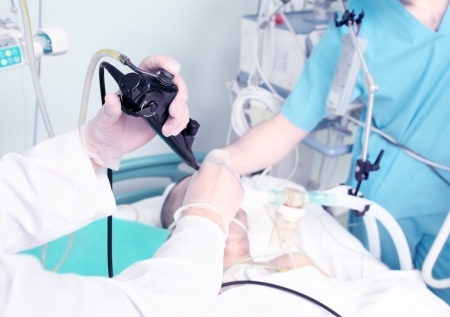Duodenoscope Superbug Infections

Duodenoscopes manufactured by Olympus Corp. and other medical device makers have been implicated in superbug infection outbreaks at hospitals around the country. It is believed that hundreds of patients were exposed to a dangerous pathogen called Carbapenem-Resistant Enterobacteriaceae (CRE) because of contaminated scopes. The duodenoscope superbug infections have also been linked to a number of fatalities.
Legal Help for Victims of Duodenoscope Infections
Bernstein Liebhard LLP, a nationwide law firm that represents the victims of defective drugs and medical devices, is offering legal assistance to individuals who were exposed to dangerous superbugs as a result of contaminated duodenoscopes. To learn more, please contact our office at (888) 994-5118.
Recent Duodenoscope Superbug Infection Outbreaks
- January 2014: 38 people were sickened by CRE at Advocate Lutheran General Hospital in Illinois. All had recently undergone endoscopic procedures with duodenoscopes. Read More
- January 2015: At least 39 patients were exposed to CRE at Virginia Mason Medical Center in Seattle after undergoing duodenoscope procedures in 2012 and 2014. At least 11 died, though it is not clear if the infections caused all of the deaths. Read More
- February 2015: At least 179 people were exposed to CRE at UCLA’s Ronald Reagan Medical Center.
How Do Duodenoscopes Spread Superbugs?
Duodenoscopes are used in endoscopic retrograde cholangiopancreatography (ERCP) procedures to diagnose disorders affecting the bile ducts and pancreas. The moving parts that make up these scopes contain many microscopic crevices, where residual body fluids and organic debris can accumulate. It has become apparent that cleaning and sterilizing duodenoscopes according to manufacturers’ specifications was not sufficient to eradicate contaminants.
FDA Warnings on Duodenoscope Superbugs
- February 2015: The U.S. Food & Drug Administration (FDA) revealed that from January 2013 through December 2014, it had received 75 reports of possible microbial transmission from reprocessed duodenoscopes involving 135 patients. The agency cautioned that the complex design of duodenoscopes can impede efforts to clean, disinfect or sterilize reusable devices.
- August 2015: the FDA issued a second communication with expanded duodenoscope cleaning procedures.
FDA Issues Warning Letters Duodenoscope Manufacturers
In August 2015, the FDA sent warning letters to Olympus, Pentax and Fujifilm accusing the companies of failing to report problems with the devices “Olympus and Pentax were specifically cited for failing to relay to FDA reports that their devices ‘may have caused or contributed to a death or serious injury’ within 30 days of learning about the event.” Bloomberg News reported. “Pentax and Fujifilm were cited for failing to make sure their instructions for cleaning the scopes were valid.” Read More
Duodenoscope Recalls and Notifications
- December 2015: Fujifilm issued an “Urgent Field Correction” that revised the instructions for the “Preparation and Operation” and “Cleaning, Disinfection and Storage” of its duodenoscopes. The notice was prompted by recent outbreaks of CRE that have been linked to such devices.
- January 2016: Olympus announces a voluntary recall of its TJF-Q180V model duodenoscope. The company intends to replace the elevator channel sealing mechanism at the tip of the scope with a new sealing mechanism in order to reduce the risk of infection.
Attorneys Investigating Duodenoscope Lawsuits
Bernstein Liebhard LLP is offering free, no-obligation legal reviews to anyone who may have been affected by duodenoscope superbug infections. To contact an attorney today, please call (888) 994-5118.
- Chicago Tribune (2014) “Superbug found at suburban hospital” http://articles.chicagotribune.com/2014-01-10/health/ct-hospital-bacteria-exposure-met-20140110_1_bacteria-superbug-cre
- CDC (February 2015) “CDC Statement: Los Angeles County/UCLA investigation of CRE transmission and duodenoscopes” http://www.cdc.gov/hai/outbreaks/cdcstatement-LA-CRE.html
- FDA (February 2015) “Design of Endoscopic Retrograde Cholangiopancreatography (ERCP) Duodenoscopes May Impede Effective Cleaning: FDA Safety Communication” http://www.fda.gov/MedicalDevices/Safety/AlertsandNotices/ucm434871.htm
- FDA (August 2015) “Supplemental Measures to Enhance Duodenoscope Reprocessing: FDA Safety Communication” http://www.fda.gov/MedicalDevices/Safety/AlertsandNotices/ucm454766.htm
- Bloomberg (August 2015) “FDA Issues Warning to Scope Makers Over Spread of Deadly Superbugs” http://www.bloomberg.com/news/articles/2015-08-17/fda-issues-warning-to-scope-makers-over-spread-of-deadly-superbugs
- Fujifil (2015) “Urgent Field Correction” http://www.fujifilmusa.com/products/medical/endoscopy/pdf/urgent_field_correction_ed_530XT.pdf
- FDA (2016) “FDA clears Olympus TJF-Q180V duodenoscope with design modifications intended to reduce infection risk” http://www.fujifilmusa.com/products/medical/endoscopy/pdf/urgent_field_correction_ed_530XT.pdf
Get the latest news and litigation updates about this case by following us on Facebook. Click the "Like" button below.
Follow Us


